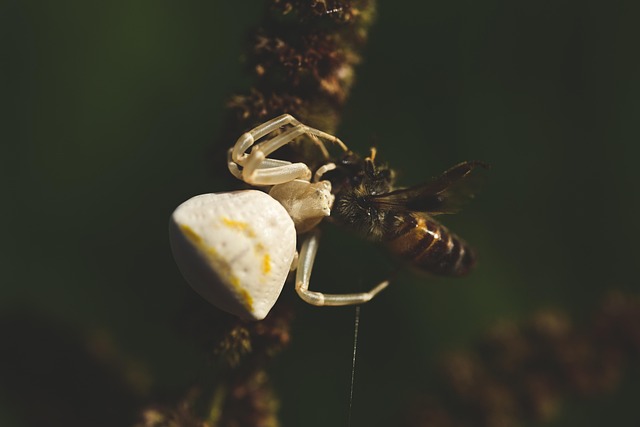Understanding spider behavior is crucial for effective spider-proofing. This includes sealing entry points, maintaining cleanliness, and using natural or outdoor-safe insecticides. A multi-step approach involves inspecting for gaps, removing webs, and employing repellents. Regular cleaning, clutter reduction, and professional services ensure a spider-free home, emphasizing the importance of a comprehensive strategy for year-round protection.
Keep spiders at bay with our comprehensive guide on spider-proofing your home. Understanding their behavior and entry points is key to effective prevention. We explore both chemical and natural solutions for thorough perimeter treatments, offering DIY strategies tailored to common problem areas. Additionally, discover long-term maintenance tips to ensure a spider-free haven. Implement these measures for a comprehensive approach to spider control and enjoy peace of mind in your home.
Understanding Spider Behavior and Entry Points
Understanding how spiders behave is crucial for effective spider-proofing your home. These arachnids are naturally drawn to dark, tight spaces and are excellent climbers, often entering through small cracks or openings. They are also attracted to food sources like insects and debris, making cluttered areas prime real estate for them. By identifying potential entry points—such as gaps around pipes, windows, doors, or vents—and sealing these with appropriate materials, you significantly reduce their access.
Regular inspections and maintenance play a vital role in spider-proofing your home. Checking for any signs of infestation, like webs or small holes, allows for early detection. Maintaining cleanliness by regularly vacuuming and wiping surfaces reduces food sources, making your home less appealing to spiders. Additionally, keeping outdoor areas tidy, especially gardens and patios, helps deter them from seeking entry into your living space.
Effective Perimeter Treatments: Chemical and Natural Solutions
Keep spiders at bay by implementing effective perimeter treatments as part of your spider-proofing strategy. Chemical solutions, while potent, should be used with caution due to their potential impact on the environment and human health. Opt for insecticides that are specifically designed for outdoor use and target spider habitats, such as cracks, crevices, and dark corners. Apply these products along the exterior walls, foundations, and any entry points to disrupt spider pathways into your home.
Natural alternatives offer a safer approach to spider-proofing. Essential oils like peppermint, citrus, and lavender are known repellents. Mix these oils with water and spray them around windowsills, doors, and other potential entry points. You can also plant herbs like mint, basil, or marigolds in gardens or near entrances, as their strong scents act as natural deterrents. These chemical-free methods not only protect your home but also contribute to a healthier outdoor environment.
DIY Spider Prevention Strategies for Common Problem Areas
Many homeowners turn to DIY solutions for spider prevention, particularly in common problem areas around the house. Spider-proofing your home involves a combination of sealing entry points and maintaining a clean environment. Start by inspecting your property for any gaps or cracks, especially around windows, doors, and utility pipes. Seal these openings with caulk or weatherstripping to block their entry. Additionally, ensure that screens on windows and doors are in good condition and fit properly.
Next, focus on decluttering and deep cleaning, as spiders are attracted to dark, dusty corners and hidden spaces. Regularly vacuum and mop floors, especially in areas where spiders might hide, such as under furniture or in crawl spaces. Remove webs promptly, as they serve as both food sources and protective shelters for spiders. Consider using natural repellents like lavender, mint, or citrus oils around entry points to discourage spiders from setting foot inside your home.
Maintaining a Spider-Free Home: Long-Term Strategies and Tips
Maintaining a spider-free home involves a combination of preventive measures and regular maintenance. One effective strategy is spider-proofing your home by sealing entry points such as gaps in doors, windows, and utility pipes with caulk or weatherstripping. Regularly cleaning and vacuuming, especially in hard-to-reach areas, helps remove webbing and egg sacs that could lead to resurging populations. Additionally, reducing clutter around the house, particularly outdoors, makes it harder for spiders to find hiding places and food sources.
For long-term protection, consider implementing a year-round treatment plan. This can include professional pest control services that specialize in spider control. Using natural repellents like lavender, mint, or citrus essential oils in strategic locations also offers an eco-friendly alternative. Regular inspections by professionals can identify potential entry points and help you address them before spiders take residence, ensuring a safer, more comfortable living environment.
By understanding spider behavior, identifying entry points, and implementing effective perimeter treatments—both chemical and natural—you can significantly spider-proof your home. DIY strategies for common problem areas, combined with long-term maintenance tips, will help keep spiders at bay. With these measures in place, you’ll create a safe, spider-free environment for you and your family.
